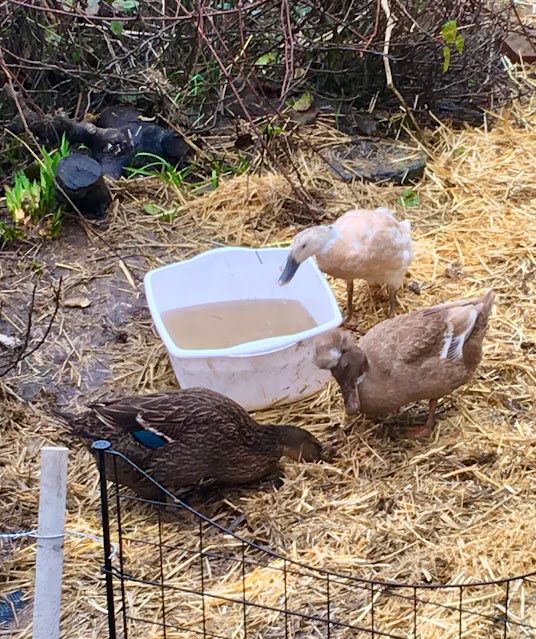My main focus in January is to plan the next season's garden, and take care of the nature that continues to live here. As always, I'd rather not go into the garden in the rain and the mud, but if I can be strong, get on my rain gear, and take a short daily tour of my garden, I find many simple things to do, without getting too muddy.
The best tip I've read in any permaculture blog is: Be consistent with 15-minutes a day, year round. I try to take a 15-minute walk through my garden each day, and I alternate the front and back gardens so I don't feel rushed.
The consistency of the 15-minute daily visit keeps me connected to my garden even when I don't accomplish much. As Amy from 10-Acre Farm says, "It helps me to enjoy 'being' in the garden, rather than always focusing on the 'doing'."
Agenda:
1. Read "A Comfort of Crows"
2. Garden plans
3. January tasks
4. Prune the Grape
1. Read "A Comfort of Crows":
 I'm loving this pretty book by Margaret Renkl (2023), subtitled "A Backyard Year"; it includes a reading for each week of the year; this week is Winter - Week 5, The Winter Garden.
I'm loving this pretty book by Margaret Renkl (2023), subtitled "A Backyard Year"; it includes a reading for each week of the year; this week is Winter - Week 5, The Winter Garden.She writes about the accepted gardening habits of tidying up, like dead heading, pulling annuals, raking leaves, and weeding. She no longer does most of these things, but instead lets the birds forage through the leaves and eat the leftover seed heads.
"Year by year, the creatures who share this yard have been teaching me the value of an untidy garden. ... An unkempt garden offers more than just food for the birds. The late offspring of certain butterflies ... spend fall and winter sealed away in a chrysalis clinging to the dried stems of what's left of a summer garden. ... Most species of native bees ... hibernate underground during winter." She reminds me not to mulch too deeply or I might block their exit in the spring.
She also reminds me that much depends on paying attention to the needs of the creatures that own my land as much as I might claim to own it.
2. Garden plans:
 |
| Ring of fall-planted garlic in January |
I am continuing the fun work of planning my garden. I've got the veggie garden roughly mapped out. I've ordered some of my veggie seeds.
My next tasks are to:
- Update my planting schedule: I need to determine the date to start each thing, and put it onto my planting spreadsheet, and my calendar. Hardiness zones are shifting, and first and last frost dates are less predictable than they used to be, but we are typically in USDA zone 8b, and Sunset zone 6, and our last frost date is now May 15.
- Update my monthly checklists: I'm going to use the Second Breakfast Garden monthly guides this year to update my checklists, because they are in zone 8b.
- Start a new garden record book: I used to keep better records, but somewhere along the line I stopped. This is the year I'm going to keep track of garden successes and failures—dates when I notice certain pests, and when I add soil amendments, for example.
- Continue to care for my ducks - cleaning the coop a little more often to keep it dry.
- Continue to feed the birds, and keep the feeders clean.
- Clean my tools and oil them (if I haven't already).
- Prune the grape, and save the vines (see below), as well as the raspberries and thimbleberries
- Dig up some raspberries to thin plants to 2-feet apart.
- Fence off the new pea bed, so the ducks keep off of it, and on a dry day, collect some leaf mulch and spread it there.
- Mulch the west path with Hawthorn leaves.
- Repair or replace boards around some beds.
We use a haphazard trellis pruning system, with a large number of canes. We put in a very sturdy trellis two years ago to handle the weight, and trained two sections of trunk to a high head height, about 5½ feet tall. I chose two shoots on each trunk to be the arms or cordons - the permanent parts of the vine, running south. These are fanned out and loosely tied to the trellis (this is important because it's hard to remember which are the permanent vines otherwise!)
Now it's time to prune, before the new growth starts. When maintenance pruning, remember that grapes grow from the buds formed on the previous summer’s stems, so don’t remove all the stems or you won’t get any fruit. We "cane prune" because I think our grapes produce better that way...
- Select four stems per cordon.
- Cut two stems back to 8 to 12 buds to create two canes.
- Cut the other two stems back to two-bud spurs.
- The following year, reverse the pruning by cutting the spurs, which will have grown into long stems, back to 8 to 12 buds to make a cane. Then prune the previous year’s canes back to two-bud spurs. Alternate the pruning on these spurs and canes each year.
- Remove all other growth.



No comments:
Post a Comment